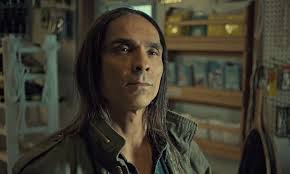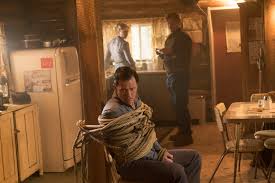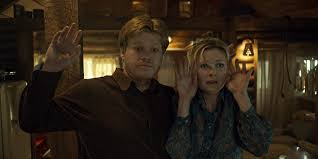
Is there anything more Fargo than a hulking criminal being taught to speak politely while being held at knifepoint by a Midwestern housewife? I submit there is not, unless the woman were also significantly pregnant at the time. I assumed that this episode would focus almost exclusively on Ed and Peggy and Dodd and Hanzee, but I thought it would be more of a cat and mouse game between the Blumquists and the hunter rather than a twisted comedy of manners between them and the Gerhardt scion. But I am so glad it became the latter.
This is in part because Dodd has been built up to be such a magnificent bastard that he makes for the ideal “victim” in this scenario. Poor Simone went to the wrong person to dish him out his comeuppance, but she would be tickled to watch this episode and see her pops get, in very short order, punched, tased, tied up, stabbed, force fed beans, partially stigmata-ed, and brained with a fire place poker by a couple of shnooks, before being shot in the head by the lackey he always treated like a dog (though still slightly better than his daughter). She may have started feeling conflicted somewhere around the beans, him being her father and all, but for those us who have watched him brutalize everyone he thinks he can get away with these last 8 weeks, an hour as a punching bag feels about right.
A fair bit of has been made about the Gerhardts representing the past, but that has generally been in the context of their family business vs. corporatization conflict with the KC syndicate, which casts them in a romanticized, John Henry-type light as hold-outs against the dehumanization of commerce. But Dodd also represents a darker side of the Old Ways, as his scorn for woman and minorities is absolute enough to make him a dinosaur even by 1970s standards, much less today’s. Milligan’s issues with his superiors may show that prejudice survives just fine in corporate clothes, but the silver lining of the inhumanity of the system is that it is less dictated by human prejudice – the bottom line is all that matters, and any other bigotry falls by the wayside until profits fall and it’s time to cast blame.
Dodd fails to recognize that his status is propped up entirely by the brains of his mother and the ruthless competence of his Tonto figure, despite ample demonstrations of those facts. And it ultimately proves his eminently-avoidable undoing, as he immediately reverts to treating Peggy as a nonentity once he’s out from under her thumb, and then insults his would-be rescuer into becoming his murderer. Fargo’s social commentary tends to be too oblique to directly address the privilege and social justice issues de jeur, but Dodd is emblematic of a type of white guy who is born on third base, but whose willful ignorance of that fact manages to get him thrown out at second.
 |
“Sir, please step away from the sports metaphors.”
|
But moving over to Hanzee, his killing spree looks at first blush like a tossed off detour, just a secondary character shooting up a bunch of asshole nobodies. Only there to fill some of that bloated runtime, meet the show’s expected quota of violence, and a check off the box that last week’s allusions required. Except that Hanzee’s experience at the bar has everything to do with his decision to kill Dodd at the cabin, and it’s a bit more complicated than just making him especially sensitive to race-related barbs. When his tours and medals fail to mitigate the assholery of the establishment in the slightest, he sees in stark and final terms that his service, no matter how diligent and singular, will never overcome the prejudice against his heritage in the eyes of these crackers. And that’s as true of the Gerhardts in this war as it is of the greater USA in Vietnam.
 |
I did not watch my friends die face down, in the muck, etc. etc…
|
Okay then, time for Coen Bros Bingo And Other Random Shit.
COEN BINGO AND OTHER RANDOM SHIT
– Dodd’s hostage situation in a remote cabin parallels poor Mrs. Lundegaard’s predicament in the film. He even has his head covered in a pillowcase at one point.
– The Blumquist’s departure from and Solverson’s arrival at the homestead is shot from an overhead view, as if it were shot by an unidentified floating object of some sort.
– I’ve been on the fence about whether the split screen device had been adding enough to justify its ostentatiousness, but it definitely worked to literalize the divide between Ed and Peggy when they’re sitting in the car, looking directly at each other from inches, but worlds, apart. It also created an interesting effect when showing him in the phone booth with his phone call going unanswered at the empty Gerhardt house.
– Blood Simple also features a woman pinning an attacker’s extremity to a windowsill with a knife.
– The bar Hanzee shoots up has carvings of the symbols Hank had plastered all over his study on the walls. Perhaps they weren’t hieroglyphs, but Sioux or Lakota writings? I dunno, I only speak American and conversational l33t5p34k over here.
- “…Hon, you gotta stop stabbing him…”
– Hanzee’s interrogation of the gas station owner is reminiscent of Chigurgh’s iconic coin-flipping session early in No Country.– Peggy doesn’t get to chat with Bruce Campbell’s Reagan as I hoped, but she does get lost in fictional picture Operation Eagle’s Nest, which Dutch told Lou about making (well, sort of – we never did find out if he made it out of that one). Ominously, its nazi villain shrugs off a shot in the back to continue stalking after the heroes. Besides presaging Hanzee’s “rescue” of the Blumquists, if you somehow had the Coen Bros making a WWII propaganda flick, this seems dead on to what they’d do.
– Hanzee is primed for ugliness outside the bar when he eyeballs a plaqued commemorating the hanging of 22 Sioux, adorned with a puddle of puke. True Grit features the darkly comic, dismissive hanging of an Indian. I’m not sure if this counts as a reference, really, but it brought it to my mind.


No comments:
Post a Comment